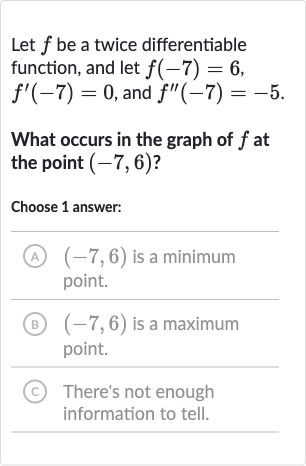Full solution
Q. Let be a twice differentiable function, and let , , and .What occurs in the graph of at the point ?Choose answer:(A) is a minimum point.(B) is a maximum point.(C) There's not enough information to tell.
- Given Information Analysis: To determine what occurs at the point on the graph of , we need to analyze the given information about the function and its derivatives at .Given: , , and .The value tells us that the point lies on the graph of .The derivative indicates that the slope of the tangent to the graph of at is zero, which means the graph has a horizontal tangent line at this point.The second derivative tells us about the concavity of the graph at . Since is negative, the graph of is concave down at this point.
- Point Characteristics: Now, we can determine what type of point is on the graph of . A point where the first derivative is zero and the second derivative is negative is typically a local maximum. This is because the horizontal tangent line indicates a potential extremum, and the concave down nature (negative second derivative) suggests that the graph is curving downwards, making it a peak or a maximum point.

